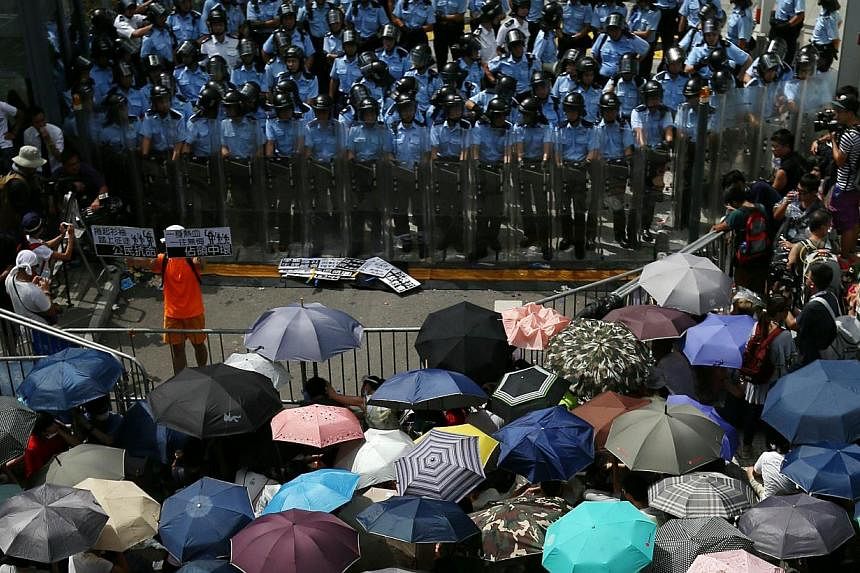On the afternoon of Sunday, Sept 28, I was right where it first started - behind the police cordon in front of which tens of thousands of protesters had massed in Hong Kong.
Minutes before, the sea of people had overwhelmed the police line at the other side of the six-lane Harcourt Road in Admiralty, before they strolled calmly onto the tarmac, forcing vehicles to turn tail. There was a bit of a festive air; some were giggling, slightly excited about the novelty of occupying the carriageway.
The atmosphere at the front line was different. Demonstrators eager to join those penned in by barricades, in front of the government office complex, were charging at the barriers. The police, meanwhile, obviously had orders to hold the line, and soon began to use pepper spray liberally; I was metres away but could already feel the effects.
It wasn't much of a deterrent though. Waves and waves of people came with umbrellas - some using it as defence, some to jab at the police, while trying to pull away the railings. I saw one police officer hit out with his baton.
Two hours later, the police unleashed tear gas. With the genie out of the bottle, they then used it multiple times - 87 rounds - throughout the night and early morning across the city centre, in a vain effort to disperse the even greater number of outraged Hong Kongers now out on the streets.
The action, almost single-handedly, triggered the so-called "umbrella movement", mobilising tens if not hundreds of thousands of people to sit in at the protest sites, far more than observers had previously predicted of the original "Occupy Central" movement.
Images of heavily armed police facing off with defenceless people with their hands in the air have since been immortalised. The dominant narrative here in Hong Kong and in some overseas media is that of a "brutal" police crackdown on peaceful protesters, most of them students.
That description is not entirely off the mark. The protesters were peaceful in that they did not set cars on fire or throw bricks. Nor did they attack officers.
But it would also not be wholly accurate to describe all the protesters as entirely peaceful, based on what I saw. When I spoke about this to friends and colleagues, one response to this was: "You must be seeing something that I can't see."
It would not be the only disagreement over what exactly has happened in the ongoing political strife in Hong Kong.
Over the past 11 days, debate has raged over different incidents, many surrounding the Hong Kong police force and its interactions with the pro-democracy protesters.
People are asking: Was that an old defenceless man trying to mediate before being pepper-sprayed - or was he himself charging at the police cordon?
Was that a hired triad thug making trouble in Mongkok - or a local resident with reason to be aggrieved with the pro-democracy protesters? Did the police deliberately dally in going to the aid of the protesters attacked - or were they truly stretched?
People looking at videos or photos of the same event - or even the same videos or photos - can come to entirely different conclusions.
Amid a movement that has deeply polarised Hong Kong, it seems, people see what they want to see.
There are two reasons for this.
One is simply that the protest movement is unfolding in a city with one of the world's highest usage of smartphones, meaning that it has become one of the most "observed" - and yet contentiously so - news developments in recent time.
Such a scenario is typical: a fracas breaks out. Immediately, all the bystanders around whip out their phones. Photos are taken, footage is filmed. On their phones, videos are niftily edited before they are disseminated on Facebook or WhatsApp.
Often, what is shared is what supports one's stance, or is simply based on the limits of where one happens to be.
Subjective or even self-interested purveying of information during conflicts or confrontations is not new of course, but there is a multiplier effect due to technology.
Another reason for the polarised interpretations is that for large swathes of Hong Kong society, the government today carries scant social, moral or political authority - which shapes societal benchmarks on what is or is not acceptable behaviour, says sociologist Lui Tai Lok of the University of Hong Kong.
"It's a situation where the authority of the government has been challenged, and the general public do think that in the face of a government they don't like, you can do something like that - at least for the moment."
What this means is that the usual definitions of "peaceful" behaviour or "proportionate" force are stretched. Actions that would have been frowned upon by most of Hong Kongers in the past as unruly, riotous and unlawful - such as charging aggressively at police cordons, pulling away barricades, blockading roads - are accepted, for the time being.
The police then are caught in a difficult position because they are still using the regular benchmarks in a normal situation, interpreting these acts as ones that call for a stern response, such as tear gas.
And with society divided between "pro-protesters" and "anti-protesters", both sides find it difficult to come to a consensus on what is permissible or not; resulting in differing interpretations of the same incident or behaviour.
It cuts both ways. Public opinion is fickle, and already, the tide is turning against the protest movement as citizens tire of the disruptions or believe that it has run its course.
If the same events of Sept 28 were to erupt today, Hong Kongers may well have a different reading of what happened and be less forgiving of protesters who charge at the police.

